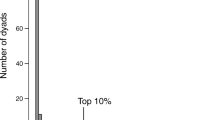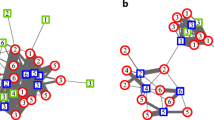A community of hamadryas baboons (Papio hamadryas) consists of a unique organization with four structural levels and marked hierarchical relationships between males and females. This makes it an ideal system for testing the hypothesis that relationship quality influences reconciliation between individuals. Post-conflict reconciliation was studied in hamadryas baboons. The behavior of 436 conflicting pairs was studied. Reconciliation was found to be characteristic of pairs of different composition, including: 1) pairs consisting of a male and a female from his harem; 2) pairs consisting of two females from the same harem; 3) pairs consisting of two related animals; 4) pairs consisting of two males; 5) pairs including a female and a young (almost adult) male. Significant differences in reconciliatory tendencies were seen in different pair categories, along with a high level of selectivity of the interactions between former antagonists, evidencing that the probability of reconciliation between hamadryas baboon individuals depends on the quality of the relationships between them.
Similar content being viewed by others
References
N. V. Meishvili, V. G. Chalyan, and M. L. Butovskaya, “Studies of reconciliation in anubis baboons,” Ros. Fiziol. Zh. im. I. M. Sechenova, 90, No. 10, 1229–1234 (2004).
V. G. Chalyan and N. V. Meishvili, “Demographic characteristics of groups of primates as a model for analogous formations in early hominids,” Sovet. Etnografiya, 2, 115–122 (1989).
V. G. Chalyan, N. V. Meishvili, and M. L. Butovskaya, “The role of females in the functioning of communities of hamadryas baboons,” Vestn. Antropol., No. 3, 126–145 (1997).
V. G. Chalyan, I. G. Pachuliya, N. V. Meishvili, and Ya. Yu. Rozhkova, “The structure-forming function of grooming in hamadryas baboons,” Ros. Fiziol. Zh. im. I. M. Sechenova, 96, No. 9, 936–942 (2010).
J. Altmann, “Observational study of behavior: sampling methods,” Behaviour, 49, 227–266 (1974).
F. Aureli, C. Veenema, C. J. Van Panthaleon van Eck, and J. A. R. A. M. van Hoof, “Reconciliation, consolation, and redirection in Japanese macaques (Macaca fuscata),” Behaviour, 124, 1–21 (1993).
C. Bachmann and H. Kummer, “Male assessment of female choice in hamadryas baboons,” Behav. Ecol. Sociobiol., 6, 315–321 (1980).
M. L. Butovskaya, “Kinship and different dominance styles in groups of three species of the genus Macaca (M. arctoides, M. mulatta, M. fascicularis),” Folia Primatol., 60, 21–224 (1993).
M. L. Butovskaya, “Reconciliation, dominance and cortisol levels in children and adolescents (7–15-year-old boys),” Behaviour, 145, 1557–1576 (2008).
M. L. Butovskaya and A. G. Kozintsev, “Group history and dominance style: the case of crab-eating monkeys,” Anthropologie, XXXIV, 165–176 (1996).
M. L. Butovskaya, A. G. Kozintsev, N. V. Meishvili, and V. G. Chalyan, “Reconciliation in Hamadryas baboons,” in: Abstr. 12th Int. Congress of the Primatological Society, Antananarivo, August 10–14, 1998, p. 132.
M. L. Butovskaya and A. G. Kozintsev, “Aggression, friendship, and reconciliation in Russian primary school children,” Agress. Behav., 25, 125–139 (1999).
M. L. Butovskaya, P. Verbeek, and A. A. Lunardini, “Multicultural view of peacemaking among young children,” in: Natural Conflict Resolution, F. Aureli and F. B. M. de Waal (eds.), University of California Press, Berkeley (2000), p. 223–250.
D. L. Castles, F. Aureli, and F. B. M. de Waal, “Variation in conciliatory tendency and relationship quality across pigtail macaques,” Anim. Behav., 52, 389–402 (1996).
D. L. Castles and A. Wihten, “Post-conflict behavior of wile olive baboons. 1. Reconciliation, redirection and consolation,” Ethology, 104, 127–147 (1998).
D. L. Cheney and R. Seyfarth, “Reconciliatory grunts by dominant female baboons influence victim’s behavior,” Anim. Behav., 54, 409–418 (1997).
F. Colmenares, “Clans and harems in a colony of hamadryas and hybrid baboons: male kinship, familiarity and the formation of brother-teams,” Behavior, 120, 64–91 (1992).
F. Colmenares, M. G. Lozano, and P. Torres, “Harem social structure in a multiharem colony of baboons (Papio spp.): A test of the hypothesis of the ‘star-shaped’ sociogram,” in: Current Primatology. II. Social Development, Learning and Behavior, J. J. Roeder, B. Thierry, J. R. Anderson, and N. Herenschmidt (eds.), University Louis Pasteur, Strasbourg (1994a), pp. 93–101.
F. Colmenares and C. Lozaro-Perea, “Greeting and grooming during social conflicts in baboons: Strategic uses and social functions,” in: Current Primatology. II. Social Development, Learning and Behavior, J. J. Roeder, B. Thierry, J. R. Anderson, and N. Herenschmidt (eds.), University Louis Pasteur, Strasbourg (1994b), pp. 165–174.
M. Cords and F. Aureli, “Patterns of reconciliation among juvenile long-tailed macaques,” in: Primates: Life History, Development, and Behavior, M. E. Pereira and L. A. Fairbanks (eds.), Oxford University Press (1993), pp. 271–284.
M. Cords and F. Aureli, “Reconciliation and relationship qualities,” in: Natural Conflict Resolution, F. Aureli and F. B. M. de Waal (eds.), University of California Press, Berkeley (2000), pp. 177–198.
G. Cowlishaw, “Behavioral patterns in baboon group encounters: The role of resource competition and male reproductive strategies,” Behaviour., 131, 75–86 (1995).
J. R. Daniel, A. J. Santon, and M. G. Cruz, “Postconflict behavior in brown capuchin monkeys (Cebus apella),” Folia Primatol., 80, No. 5, 329–340 (2009).
R. Dunbar, “Relationships and social structure in gelada and hamadryas baboons,” in: Primate Social Relationships, R. A. Hindle (ed.), Blackwell, Oxford (1983), pp. 299–307.
J. Goodall, The Chimpanzees of Gombe, Harvard University Press, Cambridge (1986).
C. C. Gruber, “Conflict and postconflict behavior in captive blackand-white snubnosed monkeys (Rhinopithecus bieti),” Primates, 45, No. 3, 197–200 (2004).
W. J. Hamilton and J. B. Rerger, “Natal male baboon rank rises and successful challenges to resident alpha males,” Behav. Ecol. Sociobiol., 26, 357–363 (1990).
G. Hausfater, J. Altmann, and S. A. Altmann, “Long-term consistency of dominance relationships among female baboons,” Science, 217, 752–755 (1982).
R. A. Hindle, Towards Understanding Relationships, Academic Press, London (1979).
H. Kummer, Primate Societies, Aldine, Chicago (1971).
A. Leone and E. Palagi, “Reconciling conflicts in a one-male society: the case of geladas (Theropithecus gelada),” Primates, 51, No. 3, 203–212 (2010).
E. Palagi, T. Paoli, and S. B. Tarli, “Reconciliation and consolation in captive bonobos (Pan paniscus),” Am. J. Primatol., 62, No. 1, 15–30 (2004).
O. Petit and B. Thierry, “Aggressive and peaceful interventions in conflicts in Tonkean macaques,” Anim. Behav., 48, 89–95 (1994).
O. Petit and B. Thierry, “Reconciliation in a group of Guinea baboons (Papio papio),” in: Current Primatology. II. Social Deve-lopment, Learning and Behavior, J. J. Roeder, B. Thierry, J. R. Anderson, and N. Herenschmidt (eds.), University Louis Pasteur, Strasbourg (1994b), pp. 137–145.
O. Petit, A. Abegg, and B. A. Thierry, “A comparative study of aggression and conciliation in three cercopithecine monkeys (Macaca fiscata, Macaca nigra, Papio papio),” Behaviour, 134, 415–432 (1997).
T. Romero, F. Colmenares, and F. Aureli, “Postconflict affiliation of aggressors in Papio hamadryas,” Int. J. Primatol., 29, No. 6, 1391–1606 (2008).
T. Romero, F. Colmenares, and F. Aureli, “Testing the function of reconciliation and third-party affiliation for aggressors in hamadryas baboons (Papio hamadryas hamadryas),” Am. J. Primatol., 71, No. 1, 60–69 (2009).
A. Samuels, J. B. Silk, and J. Altmann, “Continuity and change in dominance relations among female baboons,” Anim. Behav., 35, 785–793 (1987).
R. M. Seyfarth, “Social relationships among adult male and female baboons. II. Behaviour throughout the female reproductive cycle,” Behaviour, 64, 227–247 (1978).
S. Siegel, and N. J. Castellan, Nonparametric Statistics for the Behavioral Sciences, McGrew-Hill, Singapore (1988).
J. B. Silk, D. L. Cheney, and R. M. Seyfarth, “The form and function of post-conflict interactions between female baboons,” Anim. Behav., 52, 259–268 (1996).
E. O. Smith, “Dispersal in sub-Saharan baboons,” Folia Prim., 59, 177–185 (1992).
B. Thierry, “Patterns of agonistic interactions in three species of macaque (Macaca mulatta, M. fascicularis, M. tonkeana),” Aggr. Behav., 11, 223–233 (1985).
B. Thierry, F. Aureli, F. B. M. de Waal, and O. Petit, “Variation in reconciliation patterns across nine species of macaques,” Adv. Ethol., 32, S29 (1997).
B. Thierry, “Covariation of conflict management patterns across macaque species,” in: Natural Conflict Resolution, F. Aureli and F. B. M. de Waal (eds.), University of California Press, Berkeley (2000), pp. 106–128.
H. C. Veenema, M. Das, and F. Aureli, “Methodological improvements for the study of reconciliation,” Behav. Proc., 31, 29–38 (1994).
P. Verbeek, W. W. Hartup, and A. Collins, “Conflict management in children and adolescents,” in: Natural Conflict Resolution, F. Aureli and F. B. M. de Waal (eds.), University of California Press, Berkeley (2000), pp. 34–53.
F. B. M. de Waal, “The integration of dominance and social bonding in primates,” Quart. Rev. Biol., 61, 459–479 (1986).
F. B. M. de Waal, Peacemaking among Primates, Harvard University Press, Cambridge (1989).
F. B. M. de Waal, “Reconciliation among primates: a review of empirical evidence and unresolved issues,” in: Primate Social Conflict, W. A. Manson and S. P. Mendoza (eds.), State University of New York Press, Albany, N.Y. (1993), pp. 111–114.
F. B. M. de Waal and F. Aureli, “Consolation, reconciliation and possible cognitive difference between macaques and chimpanzees,” in: Reaching into Thought: The Minds of the Great Apes, A. E. Russon, K. A. Bard, and S. T. Parker (eds.), Cambridge University Press, Cambridge (1996), pp. 80–110.
F. B. M. de Waal and L. M. Luttrell, “Toward a comparative socioecology of the genus Macaca: different dominant styles in rhesus and stumptail monkeys,” Am. J. Primatol., 19, 83–109 (1989).
F. B. M. de Waal and A. van Roosmalen, “Reconciliation and consolation among chimpanzees,” Behav. Ecol. Sociobiol., 5, 55–66 (1979).
F. B. M. de Waal and D. Yoshihara, “Reconciliation and redirected affection in rhesus monkeys,” Behaviour, 85, 224–241 (1983).
F. B. M. de Waal and R. M. Ren, “Comparison of the reconciliation behavior of stumptail and rhesus macaques,” Ethology, 78, 129–142 (1988).
D. P. Watts, “Post-conflict social events in wild mountain gorillas. I. Social interactions between opponents,” Ethology, 100, 139–157 (1995).
R. M. Wittig, C. Crockford, E. Wikberg, et al., “Kin-mediated reconciliation substitutes for direct reconciliation in female baboons,” Proc. Roy. Soc. B., 274, No. 1, 1109–1115 (2007).
F. Zaragoza and F. Colmenares, “Reconciliation and consolation in hamadryas baboons, Papio hamadryas,” Adv. Ethol., 32, 158 (1997).
Author information
Authors and Affiliations
Corresponding author
Additional information
Translated from Rossiiskii Fiziologicheskii Zhurnal imeni I. M. Sechenova, Vol. 97, No. 8, pp. 870–876, August, 2011.
Rights and permissions
About this article
Cite this article
Butovskaya, M.L., Chalyan, V.G. & Meishvili, N.V. Reconciliation in Hamadryas Baboons (Papio hamadryas): Testing the Relationship Quality Hypothesis. Neurosci Behav Physi 43, 492–496 (2013). https://doi.org/10.1007/s11055-013-9760-x
Received:
Published:
Issue Date:
DOI: https://doi.org/10.1007/s11055-013-9760-x




